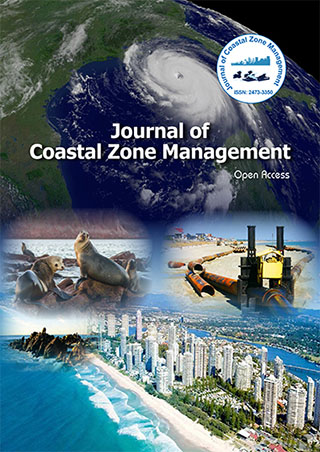Indexed In
- SafetyLit
- RefSeek
- Hamdard University
- EBSCO A-Z
- OCLC- WorldCat
- Publons
Useful Links
Share This Page
Journal Flyer

Open Access Journals
- Agri and Aquaculture
- Biochemistry
- Bioinformatics & Systems Biology
- Business & Management
- Chemistry
- Clinical Sciences
- Engineering
- Food & Nutrition
- General Science
- Genetics & Molecular Biology
- Immunology & Microbiology
- Medical Sciences
- Neuroscience & Psychology
- Nursing & Health Care
- Pharmaceutical Sciences
Abstract
Sea-level Rise and Coastal Vulnerability: A Preliminary Assessment of UAE Coast through Remote Sensing and GIS
P. Subraelu*, M.M. Yagoub, Ahmed Sefelnasr, Kakani Nageswara Rao, Raj Sekhar A, Mohsen Sherif and Abdel Azim Ebraheem
The eustatic sea-level rise due to global warming is predicted to be about 42 cm to 98 cm by 2100. Global measurements specify that the rise in sea-level is persistent or close to the worst case scenarios. In this regard, Coastal areas around the world will bore the brunt, because of inundation and flooding as storm surges are predicted to increase in frequency and severity, coupled to the inundation due to higher sea levels. It is necessary at this juncture, to identify local and regional level coastal vulnerability, using advanced geo spatial technologies and protect the vulnerable sections of UAE coasts. The UAE coast, which includes tourist resorts, ports, hotels, residential complexes, and mega construction projects, will have threat from the impending eustatic sea-level rise. Evaluation of vulnerability level of UAE coast as an illustration, is corroborated in this study using six physical variables, namely geomorphology of the coast, coastal slope, coastal land use/land cover (LU/LC), shoreline change, mean spring tide, and significant wave height. A coastal vulnerability index was meticulously studied by integrating the weighted rank values of the six variables, based on which the shoreline is divided into very high-risk, high, moderate, and low categories. About 13.8% of the studied 500 km-long UAE coast is under very high-risk, followed by another 19.4% under high risk, and 47.5% under moderate risk category, finally 19.3% under low risk category. These results contributes in assisting the planners and authorities to mitigate the disasters, adapt and design optimal coastal structures in these susceptible sections of the coast from the impending eustatic sea-level rise and storm surges.
Published Date: 2021-11-16; Received Date: 2021-10-26
